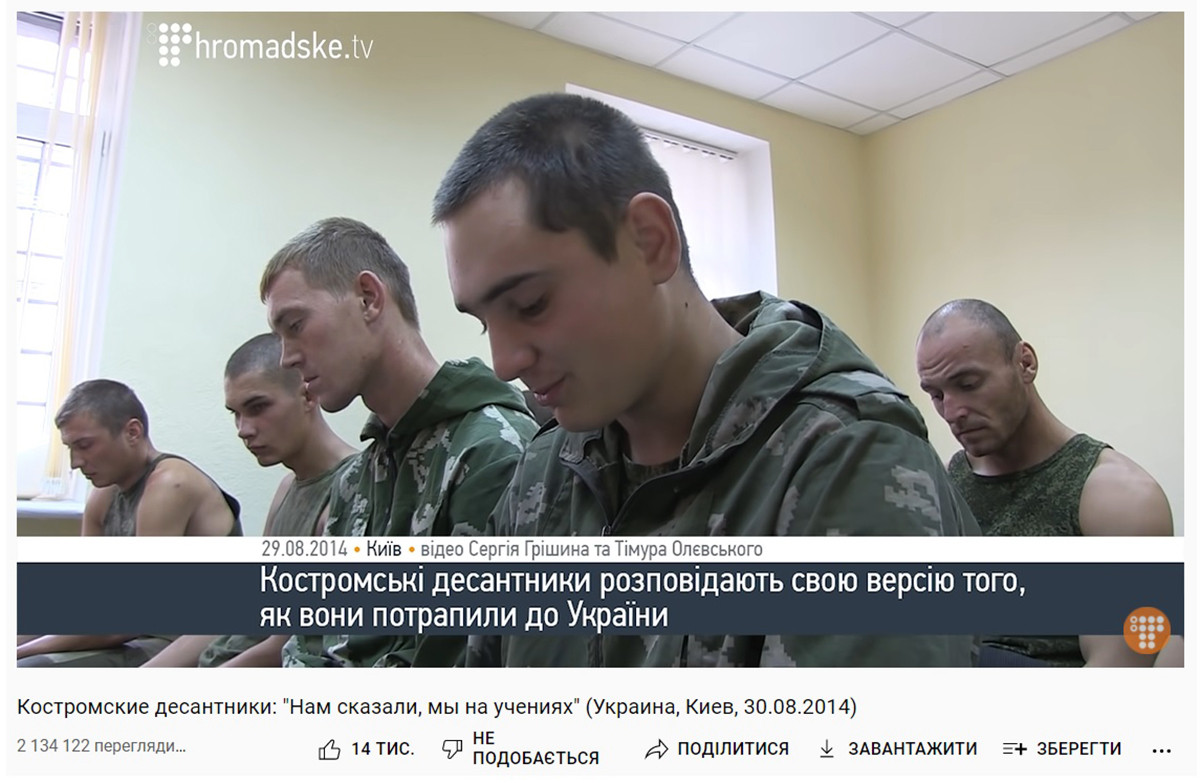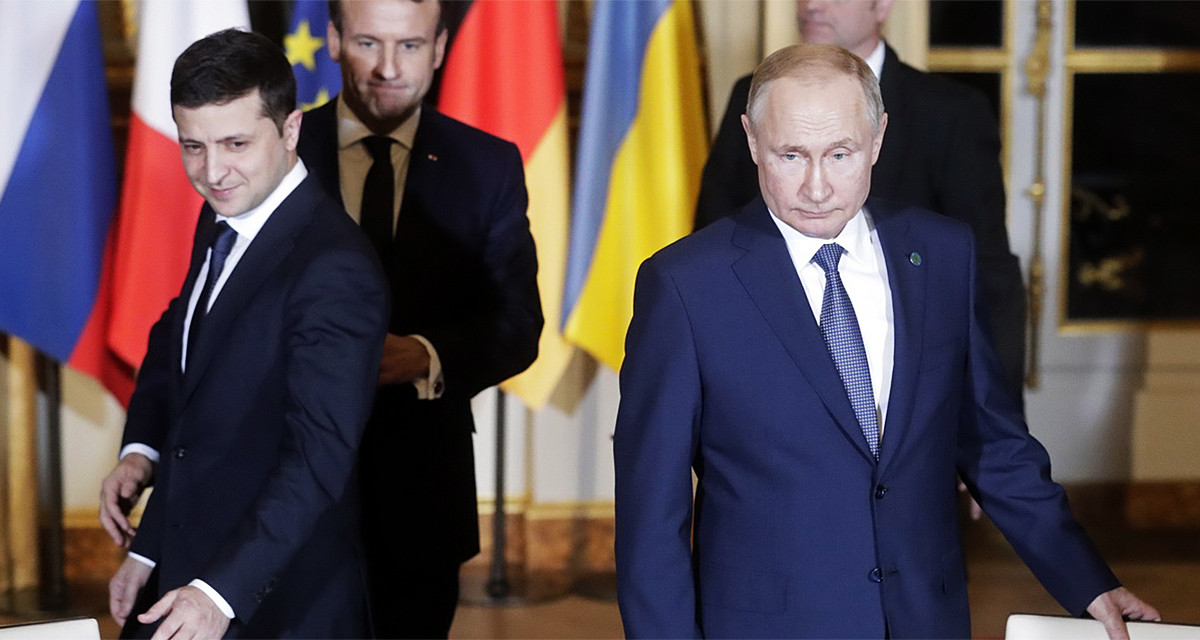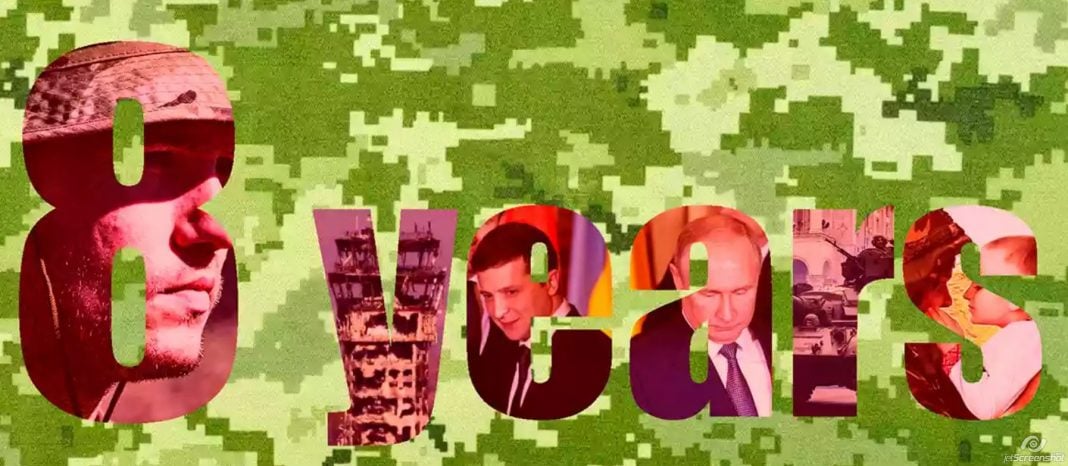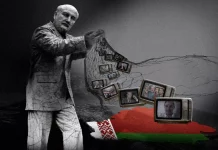By Yaroslav Zubchenko, for Detector Media
“Why were you silent for eight years while children were killed in Donbas?” This line with some variations is currently one of the most popular arguments of those who support Russia, as well as the essence of all Russian propaganda about Ukraine. It accuses Kyiv of starting the aggression, justifies any atrocities against our country and messes with the moral right to criticize the Kremlin’s actions. Propagandists, bot networks and honest Russophiles use this argument so much that during the first week of a full-scale invasion every Ukrainian has already known what “eight years” mean. And the line itself has become one of the markers of identification “our people or outsiders”. Like “palyanytsia” inside out.
It is a single sentence, nonetheless it contains years of lies. Perhaps it is the most hypocritical lie in the contemporary history of Russia, as, in fact, every Russian should be asked this question.
What is Donbas?
“Donbas” itself is the fundamental manipulation though it may not be obvious. It is meant to comprise the territory of Donetsk and Luhansk regions that Russia separates from and even opposes Ukraine in its propaganda. Thus, the “suffering of Donbas” sounds like something separate from the suffering of all Ukraine. It’s as if we were talking about the pain of Pearl Harbor in 1941, not the United States. Secondly, such a separation is needed to promote the rhetoric of the civil war. Like, Donbas itself wants to separate, because it differs so much from other Ukraine, it has never been its native part and it is overall closer to Russia.
It is not true. In fact, most of the territories called Donbas were included in all forms of Ukrainian state throughout history. The headquarters of the Zaporizhian Sich Cossacks were situated there, these lands were part of the Ukrainian People’s Republic, and then of the Ukrainian Soviet Socialist Republic after the Soviet occupation. Donbas was part of the Zaporizhian Sich a hundred years before the United States bought Louisiana from France. Does anyone have a doubt about Louisiana’s place today?
The Soviet occupation is especially symbolic in this sense. It was the occupation indeed, because a hundred years ago (1917-1922) Russia also tried to capture Ukraine. And not only modern Donetsk and Luhansk regions were our territory, but they also offered armed resistance to Moscow together with other parts of Ukraine. The Russians managed to win, establish their government, and annex Ukraine to the Bolshevik state. But note that even the Soviets left Donbas as part of the Ukrainian Republic. This is important because some other territories formerly owned by Ukraine were simply added to Russia by the Communists. For example, Taganrog district was a part of Donetsk province of Ukraine until 1925 and 71.5% of its population were Ukrainians. Kuban had twice as many Ukrainians as there were Russians. Nevertheless, the Soviet authorities changed the affiliation of these lands, but left Donetsk and Luhansk in Ukraine. According to the Imperial census of 1897, the majority of Donbas population spoke Ukrainian back at the time.

Ukrainian troops in Bakhmut 104 years ago
After that the process of Russification started all over Soviet Union. Planting Russian language in schools or its propaganda is a long story, but here’s a clearer one. Until 1924 Donetsk was called Yuzivka because it was founded by British businessman John Hughes. The Soviet Union decided to do things in a big way and renamed the city after Stalin immediately. So, current anti-Western sentiment that Russia is trying to impose in the occupied territories looks bitterly ironic given the real history of Donbas. In the XIX century it was a European region, where industry was largely created by entrepreneurs from the West. They also founded settlements, in particular German New York in the Bakhmut district. All this was carefully erased by the Soviet authorities.
And then it was time for Ukraine’s Independence. During the referendum on December 1, 1991, 83.9% of Donetsk and Luhansk regions residents answered “yes” asked “Do you confirm the Act of Independence of Ukraine?” Basically the same as it was in Odesa and Kharkiv regions.
Thus, Donbas had always been a part of Ukraine and remained it again in 1991. The next point is its relations with other regions. They cannot be measured objectively, but Donbas was equally represented in all spheres of Ukrainian society before the beginning of the Russian-Ukrainian war in 2014. The most successful Ukrainian football club in latest history was Shakhtar Donetsk owned by the richest man in Ukraine, Donetsk businessman Rinat Akhmetov. In the parliamentary elections of 2006, the Party of Regions got the most votes for the Verkhovna Rada, being a political force created and led mainly by people from Donbas. They associated themselves with it in political agitation, and again received the majority of votes in 2007 and 2012. In 2010 Viktor Yanukovych, the leader of this party, became the President of Ukraine. Do you see how grotesque the situation is? Russian propaganda is trying to tell that the region that dominated the political life of the country was oppressed in the course of history, and to separate it from the state.
Unfortunately, it had been the political struggle that created those cracks Russia used later. The rhetoric of “fear of nationalists” was present in Ukraine since the days of the Soviet Union: it was used to discredit Vyacheslav Chornovil in the first presidential election. But the real division of the state was arranged by Viktor Yanukovych’s party strategists in 2004. The Party of Regions decided to divide Ukrainians into “our people” and “outsiders” in order to mobilize the electorate and give “our people” motive to vote so that “outsiders” would not win. Technically, this was a typical strategy, but the regionals chose not the conventional economic views of citizens for the watershed, but the very region they lived in. Their campaign materials were convincing the people of Donbas that other Ukrainians considered them to be sort of “third raters”. Take a look at the political advertisement and you will see the predecessors of many highlights of today’s Russian propaganda. Moreover, Yanukovych’s election campaign singled out residents of Donetsk and Luhansk regions into a political Donbas that “chooses Yanukovych.” No other candidate, before or since, was selling himself to the electorate at the national level as a “choice” of Halychyna, Polissya or the Black Sea region. This is absurd when you aim at being the President of the whole state. And yet, history showed that this split and radicalization brought victory to the Party of Regions.

Dark PR from the Party of Regions. In ten years, the territories marked in yellow would become the borders of Putin’s “Novorossiya”
Ten years of such political games could not but deepen the linguistic, historical, geopolitical “cracks” between the regions of Ukraine. But there was no strong separatist sentiment in Donbas, and it was crucially important. It is difficult to prove the absence of something, but you may look, for example, at the public rhetoric of Catalonia in Spain, and then at the public rhetoric of Donetsk and Luhansk until 2014. There are no noteworthy movements for independence or accession to Russia, except for the marginal ones.
You may also look at the sociology of Donbas. According to a poll of February 2014, only one in three Donetsk residents and one in four Luhansk residents wanted to unite all of Ukraine with Russia. According to a poll of 2016, 72% of residents of the free territories of Donbas wanted the region to be a part of Ukraine, 8% were in favor of joining Russia and only 4% were in favor of independence. Here are the separatism and those people who need to be “liberated” from the Nazis in Kyiv.
From today’s point of view, the tales about the desire of Donetsk and Luhansk to be with Russia sound even more absurd. Because, for example, Mariupol is located in Donetsk region. And it did not just refuse joining Russia of its own free will. Moscow has unleashed a real local genocide and still cannot take it even by force. This story was especially vivid because in 2014 Mariupol had been under control of Russian militants for a month, but Ukrainian army managed to liberate it. Who knows, if the city had remained Russian then, would it be lied about today, as if it always wanted to be with Moscow and it was impossible to imagine anything else? On the other hand, if Donetsk and Luhansk had been liberated then, they would probably stand up against Russia today the same as Odesa and Kharkiv. Unfortunately, eight years ago, Ukraine was not prepared for war and failed to defend all of its territory from the Russian army.
Who is shooting in Donbas?
The line about “killings in Donbas” sounds like Ukraine is aggressing against its own population. Russian propaganda has been trying to promote this idea of civil war for eight years. Moreover, such viewpoints were voiced even by some peculiar Ukrainian politicians, mostly from the party whose leader’s daughter had the President of Russia for godfather. Well, it is worth remembering the beginning of these eight years.
In February 2014, Russia annexed Crimea. There was no point in proving this fact, as in April of that year Putin personally acknowledged the involvement of the Russian army that had been initially concealed. Moreover, there is a medal “For the return of Crimea”, dated February 20, 2014. It shows that the military operation began before the escape of former Ukrainian President Viktor Yanukovych and that the Crimean “referendum” was just a formality. In fact, the illegitimacy of the “referendum” showed even in its organization: without independent observers and the opportunity to vote for maintaining the status quo in Ukraine, with underlying suppression of freedom of speech. Although, it all wanes in comparison with the main problem: according to the Ukrainian Constitution, changes in the territory of the state are possible only through all-Ukrainian referendum. And not through an incomprehensible poll organized by Russia in the occupied territories. Long story short, in February 2014 the Kremlin seized the first piece of Ukraine using the army. Kyiv was not ready for large-scale defense then, and everything was limited to local clashes. But it was an armed aggression and the beginning of an undeclared war against Ukraine.

Russia also denied its presence in Crimea. And then it erected a monument to its own lies. It is named after the concealed Russian troops: “To Polite People”
The next key point is why Russia needs Crimea. The humanitarian version of aiding Russian-speakers should be rejected immediately. First, you can just help, annexing a piece of another country is not necessary. Secondly, considering shelling of Ukrainian maternity hospitals and columns of refugees from destroyed cities by Russia, its hard to believe its altruism.
In 2014, the Revolution of Dignity took place in Ukraine being a very dangerous precedent from the point of view of the Russian authorities. It meant that the neighboring post-Soviet country was able to overthrow the pro-Russian government and choose the path of reform and European integration. This situation could have inspired the Russian people and, more importantly, could take Ukraine out of the Kremlin’s influence. The annexation of Crimea significantly undermined these aspirations of Ukrainians. It is difficult to join the European Union or NATO having a territorial conflict. And it is impossible to completely get out of Russia’s influence if it controls a part of your territory.
And yet declaring the peninsula a part of Russia was not the completion of the Kremlin’s plans, it was only the beginning. Without hesitation, Putin denied the existence of Ukraine as a separate state, considering it a USSR creation, and at the same time called the territories of the former Soviet Union “historical Russia” in his numerous speeches. Back in 2008, Putin threatened to annex Crimea and eastern regions of Ukraine. Right before the large-scale offensive, he spoke of the “historic lands of Russia” again and promised Ukrainians “true decommunization.” Ukrainian and Western politicians have been talking about Putin’s desire to revive the Soviet Union for years. In addition, on February 26, the Russian propaganda media RIA Novosti accidentally published an article prepared for the victory over Ukraine. It was about “resolving the Ukrainian issue” and bringing Ukraine back to the bosom of Russia. All these details are important because they prove that the annexation of Crimea as such was not a goal. With this first step, Moscow simply created a base for control over the Ukrainian sea (and now we see the result of the blockade) and the complete occupation of Ukraine.
The second step was the aggression in spring of 2014. Today it is common to speak of these events as of “war in Donbas.” But in fact, the choice of region could be called random as it was the only place Russia was able to take a foothold in. Initially it has much more ambitious plans, and the events in Donetsk and Luhansk regions did not differ much from those in other regions. The same “people’s republics” were proclaimed in Odessa and Kharkiv, and it happened before that of Luhansk. The same attempts were made in Zaporizhia, Dnipro, Kherson, Mykolaiv. Vladimir Putin was so sure of Russia-inspired “separatism” that he publicly listed the regions that “were not a part of Ukraine” and named them “Novorossiya” on April 17. It included all the eastern and southern regions state. Five out of seven regions that Putin listed were defended by local activists and law enforcements. And today there are no hints of separatism there, they are all fighting against Russia for independence. And it is not easy for the occupiers to find “local elites” who are ready to cooperate with them in the occupied territories.

“For the Russian Spring! Crimea-Donbas-Odesa-Kharkiv”
Russia’s desire that did not come true
In 2014 there were efforts to liberate Donbas from the occupiers, as it was done with other regions. Today Russian propaganda likes to tell that the proclamation of “people’s republics” has been a response for the anti-terrorist operation launched by Kyiv. Or that some Nazis came to bomb Donbas so that it did not speak Russian and fell in love with Bandera. But the elementary timeline proves that this was not the case. First, the Donetsk City Council spoke about the referendum on the “fate of Donbas” on March 1. It was followed by the seizure of administrative buildings, the beating of pro-Ukrainian protesters, and the detention of separatist leaders. But there was no anti-terrorist operation yet. On April 7, some people proclaimed the Donetsk People’s Republic and asked Putin to send in troops. No anti-terrorist operation followed. It was only when gunmen actually captured Slovyansk and Kramatorsk on April 12 that the Ukrainian authorities announced the launch of an anti-terrorist operation. Everything was very similar to the events in Crimea that happened a month ago: some “green men” came again, a threat to territorial integrity appeared again and the citizens were occupied again. Ukraine started defending its territory, like any other state in such a situation.
For eight years, the main task of propaganda in Russia has been proving that it has not violated its borders and is not fighting in Donbas. As if Ukraine is defending its territorial integrity from internal “separatists”. Well, this myth was also debunked as early as in 2014. The first assault on the Ukrainian city, namely Slovyansk, was led by Russian officer Igor Girkin, as he admitted himself. His quotes confirm that if it was not for Russia, there would be no war, everything would end the same way as in other “republics”. “If our detachment had not crossed the border everything would have ended the same as in Kharkivand Odesa. There would be several dozen people killed, burned, arrested. And that would be the end of it. And practically the flywheel of the ongoing war was launched by our detachment. “
There is no point to deny that most of the militants had Ukrainian citizenship. But they were only executors, while the organizer and supplier of weapons was Russia. 500 tanks and 900 armored vehicles cannot be found in any of the “mines.” Especially if some of them are produced only in Russia. According to our army data, there were about 2,000 Russian regular officers in the occupied territories in November 2021. In 2014, the militants themselves spoke of “three to four thousand volunteers from Russia.” The Pentagon estimated the number of Russians (combatants and service staff) at 15,000 in 2015. Russia shelled Ukraine from its territory and used active military units. Two biggest defeats of Ukraine, Ilovaisk and Debaltseve, were caused by the use of Russian active units. Quoting Alexander Lukashenko in 2014: “If it weren’t for Russia, the days of the DPR and LPR would have been long gone.”

“Paratroopers from Kostroma tell how they appeared in Ukraine from their viewpoint.” “We were told it was a training exercise (Ukraine, Kyiv)”
Russian troops participate in “exercise” since 2014
Nevertheless, Ukrainian army managed to liberate and defend more than half of the Donetsk and Luhansk regions in course of this anti-terrorist operation. Respectively, summing up a smaller occupied part to the whole of “Donbas” we legitimize the propaganda of regional separatism and territorial claims of fake Russian republics. They are known to spread to the borders of regions even though today these areas are standing against the Russian occupation to the last drop of blood.
Who has been doing what for eight years?
“Why have you been silent for eight years” is an accusation of inaction. All the years of the war, Russian propaganda and its Ukrainian branches have been trying to prove that the fighting continues only because Ukraine does not want to end it. It does not want to negotiate, does not stick to agreements, threatens the inhabitants of the occupied territories. Fortunately, this Russia’s manipulation is the easiest to refute.
But let us appeal to reason first. During all these eight years, Ukraine had two tasks: to prevent the conquest of new territories and to return the occupied ones. It all had a single goal: to finally end the war that hinders life and development of the state. Everything is clear with the defense part as the armed offensive is repelled with weapons. And we had examples of such attacks: for example, one and a half thousand square kilometers around Debaltseve that were to be controlled by Ukraine according to the Minsk agreements but were later captured by Russia. However, everything is quite simple with the return as well, as Kyiv has always been saying that it intends to use diplomatic means only. Getting people and territories back without losing resources and lives is the most advantageous way. At the same time shelling hinders reintegration. Nobody wants to live in the country that makes your relatives suffer, it is proved at least by the attitude of Ukrainians to Russia today.
The fact that Ukraine did not want to shoot and did not try to get Donetsk and Luhansk back by force is proved in practice as there has been no large-scale offensive at the front since 2015. In 2020, Ukrainian Commander-in-Chief Ruslan Khomchak named some practical reasons for this, such as too many potential casualties among military and civilians, accusations of violating humanitarian law, and Russia’s superiority in resources. Simply put, Ukraine did not want and probably could not “capture Donbas.” It has always been aspiring to restore her integrity peacefully. Only 8% of Ukrainians were ready to let the occupied territories go in 2020.
However, Russia continued to hold to a part of Donbas in order to fulfill its goals, so it sabotaged all ways of settlement and diplomatic process. For example, in 2014 it refused to participate in consultations on the Budapest Memorandum, a document in which it promised to respect Ukraine’s borders and not to use force against it. Russia agreed to only one meeting of Normandy format leaders in the last five years, and refused, for example, to participate in the meeting of foreign ministers. The Kremlin also was consistently refusing to participate in the bilateral meeting between the presidents of Russia and Ukraine either because of “external management” or because they did not want to discuss the “Donbas issue” specifically. And Russia has consistently failed to follow the Minsk agreements not only in terms of a ceasefire, but also in the withdrawal of weapons or the admission of the Organization for Security and Cooperation in Europe mission. These are the first points of the agreement, and all the others are impossible without them. Do you see a trend here? And these are just the diplomatic initiatives thwarted by Russia. It showed some “creativity” as well, for example, distributing its passports in the occupied territories.

Putin’s first and last agreement to meet Zelensky
Thus, Russia did everything to hinder the diplomacy, so the weapons spoke instead. The Kremlin not only provoked the killings, but it also actively supported them. It literally refused to follow the ceasefire. It allowed the militants to shoot first. And it technically ended one truce with the Ukrainian military being targeted by snipers.
The fighting continued, the civilians were dying, children as well as adults. OSCE statistics (2017-2020) showed that the number of civilian deaths in the occupied territories was almost twice as high as in the unoccupied territories. Another independent report from the International Crisis Group gives the following explanation: “The higher civilian casualty rate in non-government-controlled areas is due to the fact that these places are more urban and populous[…] Together, the numbers suggest that neither side is trying to hit civilians but also that combatants are not doing all they can to avoid collateral damage.”
The death of the children should be addressed separately. “Why were you silent for eight years while children were killed in Donbas?” sounds as if Ukrainian army is shelling children. But OSCE suggest other causes of death: 87% of boys died because of being careless with explosives. In this context, the International Crisis Group also recalls Russian propaganda, for example, when “they announced that a Ukrainian drone strike had killed a five-year-old boy in a Donetsk suburb. In fact, the boy had died some 15km from the front, out of the Ukrainian drones’ range, possibly by setting off an unexploded shell he found in his yard.”
According to the OSCE, mines and other unexploded armaments are the second most common cause of civilian casualties in Donbas after shelling with heavy weapons. The international crisis group criticizes Russian militants in this context: “Meanwhile, de facto officials tend to be unwilling to admit that shooting from positions in areas like the Donetsk suburbs can provoke return fire and lead to civilian deaths. They have baulked at suggestions that they move their troops to keep locals out of the line of fire.” The shelling from residential areas of the occupied territories was also reported by Bellingcat. On the other hand, the International Crisis Group blames Ukraine as well: “Public figures in government-controlled Ukraine sometimes overlook or minimise the problem of civilian casualties from live fire. Losses among civilians frequently do not make it into Ukrainian news reports, partly due to journalists’ lack of access to reliable sources in areas across the line; media tends to focus on the heroism of government troops.” It is possibly the only argument in favor of “eight years of silence” claim.
Meanwhile it cannot be denied that Ukraine tried to reduce the casualties. Back in June 2014, President Petro Poroshenko declared a truce, which ended only after 63 militant attacks on Ukrainian positions and 23 Ukrainian soldiers dead. One of the most effective ceasefires under President Zelensky ended, in part, after Russian snipers killed six Ukrainian servicemen in two months. It is understandable that sniper shootings were completely purposeful, and the occupiers deliberately broke the “silence.” However, during this truce the number of civilian casualties decreased tenfold, according to the International Crisis Group.
The Ukrainian authorities complied with the ceasefire even when it was unpopular. BBC describes one such case: “The story of Yaroslav Zhuravel’s death, the Marine whom they had not been able to take from the battlefield after he had been wounded a few days before the armistice, also had an impact. “It demotivated the 35th Brigade and all the Marines. When he died, the front was active on Horlivka-Shumy line, where the Marines were stationed. And it was the 35th Brigade that got the strictest order to remain silent at all costs,” — says Olexander Karpyuk, who works with the Marines.” Ukraine kept to such terms of the armistice that people got worried, and the army commander-in-chief had to explain that Ukrainian military could fire back. Also, the government had conducted several stages of disengaging the troops on the front line despite the opposition and fear among the society.
The politicians who make these decisions this have always been talking only about the diplomatic path. Ukraine really was making efforts not to let anyone shoot in our country.
Time answered all questions
If someone still trusted Russia before February 24, now it would be difficult to repeat this mistake thanks to its own actions. Would you listen to the state which prohibits the word “war” itself under the threat of criminal liability, justifies this war by some “denazification” and deliberately kills civilians? Would you listen to the Minister of Foreign Affairs, who denies the invasion on the 16th day of this invasion? You basically will not listen to people who lie to the whole world that it is “just exercise” and then attack from three sides. The scale of Russia’s actions has made its lies visible from space. During the combat actions in the east of Ukraine you had to look closely at Donbas to notice the same grotesque lies.
This large-scale aggression has given those who were deceived by Russia before the chance to reevaluate its actions. You can see in Mariupol how Moscow is protecting Donbas and Russian-speaking people and how the people of this region dream of being part of Russia. It is obvious in Kherson how “republics” arise naturally and on their own initiative. You can appreciate Russia’s humanism all over Ukraine, in those places where Russian army first blocks and then shells humanitarian corridors. All the independence and subjectivity of the so-called republics stands out, given the fact that Russia forcibly mobilizes and disposes of the population of the occupied territories. Their desperate attempts to somehow justify all these killings (where are we at now, delivering Slavic blood to Germany?) illustrate how conclusive their arguments are. And the Russian government’s disregard for international courts and UN resolutions gives the best image of their diplomacy. Apparently, lots of people are now reconsidering their attitude to the previous eight years.
So, what can you answer to “Why were you silent for eight years while children were killed in Donbas?” Here is the short answer: “Ukraine was not silent. We gave lives of 4,000 soldiers for Donbas, but part of it was still occupied by Russia. We were knocking at the doors of the highest international bodies, but a member of the UN Security Council used its veto power. We wanted diplomacy, but it was ignored. We just stopped firing, but they kept firing at us. The leaders of Ukraine and concerned leaders of other countries of the world used all available means so that Russia gave up the war. So that Russia no longer caused the killing of Ukrainian children. And against this background, the question for every Russian arises: why did not you stop the aggression of your state? Why did you remain silent for eight years while the children of Ukraine were killed?”
By Yaroslav Zubchenko, for Detector Media





